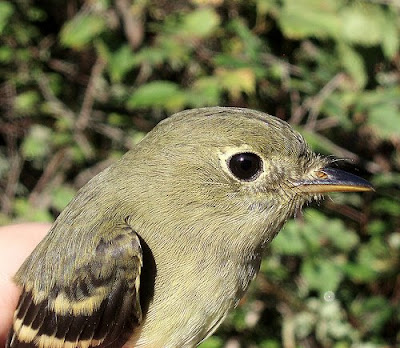 Joe's comment on my last post reminded me that it's that time of year to address the perennial bald bird issue. It is one of the most frequently asked questions about birds. Northern Cardinals (Cardinalis cardinalis), Blue Jays (Cyanocitta cristata), and Common Grackles (Quiscalus quiscula) are the most common victims of this disturbing-looking feather loss.
There's nothing wrong with most of these birds, despite how bad they look. All birds replace all of their feathers at least once a year, and fall is often the time that North American birds undergo this complete molt. Typically, this molt takes place over a few weeks. But some individuals, unfortunately, lose all the feathers on their head at the same time.
I've often read that ectoparasites such as feather mites are responsible for this condition. I have never found mites on bald birds that I've banded. All birds have some of these mites -- they feed on oils, fungi, and bits of skin, and don't cause feather loss. It would also be unlikely, if not impossible, that they would cause all the feathers in one area to fall out simultaneously. In fact, they typically move to tail and wing feathers -- cooler locations on the bird's body -- in warm weather such as is typical in fall.
There are a couple of other types of mites found on birds, but they have not been found on bald birds. My search for information on quill mites, for instance, didn't even turn up any evidence that they've been found on cardinals or jays. Nor does it make sense that these other mites would cause feather loss on the head but not elsewhere, since birds are not able to remove them easily from anywhere on their bodies via normal preening.
Although the role of mites in bird baldness has not been thoroughly studied, the seasonal and localized nature of the baldness and the fact that it is most common in a relatively limited number of bird species leads me to believe that their presence is coincidental and not causative. That this catastrophic molt is "normal" in at least some individual birds comes from Cornell staffer and former wildlife rehabber Laura Erickson. She was in charge of a Blue Jay in captivity that always lost all the feathers on its head simultaneously once a year -- for the 8 years she had it!
Sometimes bald birds are seen at other times of the year when they would not be expected to be molting. The reason for their feather loss may be different (running into a window, for instance, could cause at least a temporary loss).
Joe's comment on my last post reminded me that it's that time of year to address the perennial bald bird issue. It is one of the most frequently asked questions about birds. Northern Cardinals (Cardinalis cardinalis), Blue Jays (Cyanocitta cristata), and Common Grackles (Quiscalus quiscula) are the most common victims of this disturbing-looking feather loss.
There's nothing wrong with most of these birds, despite how bad they look. All birds replace all of their feathers at least once a year, and fall is often the time that North American birds undergo this complete molt. Typically, this molt takes place over a few weeks. But some individuals, unfortunately, lose all the feathers on their head at the same time.
I've often read that ectoparasites such as feather mites are responsible for this condition. I have never found mites on bald birds that I've banded. All birds have some of these mites -- they feed on oils, fungi, and bits of skin, and don't cause feather loss. It would also be unlikely, if not impossible, that they would cause all the feathers in one area to fall out simultaneously. In fact, they typically move to tail and wing feathers -- cooler locations on the bird's body -- in warm weather such as is typical in fall.
There are a couple of other types of mites found on birds, but they have not been found on bald birds. My search for information on quill mites, for instance, didn't even turn up any evidence that they've been found on cardinals or jays. Nor does it make sense that these other mites would cause feather loss on the head but not elsewhere, since birds are not able to remove them easily from anywhere on their bodies via normal preening.
Although the role of mites in bird baldness has not been thoroughly studied, the seasonal and localized nature of the baldness and the fact that it is most common in a relatively limited number of bird species leads me to believe that their presence is coincidental and not causative. That this catastrophic molt is "normal" in at least some individual birds comes from Cornell staffer and former wildlife rehabber Laura Erickson. She was in charge of a Blue Jay in captivity that always lost all the feathers on its head simultaneously once a year -- for the 8 years she had it!
Sometimes bald birds are seen at other times of the year when they would not be expected to be molting. The reason for their feather loss may be different (running into a window, for instance, could cause at least a temporary loss).
Being bald is not harmful to birds, except perhaps in cold or wet weather. Within a few weeks, the feathers will grow back.
For more photos and information, see the Cornell web site. Top photo of a bald cardinal by Jimmy Smith.
Janet Hug from Commerce Twp., MI sends us this photo of an adult male cardinal at her feeder, on the road to refeathering, but still looking pretty shabby.








